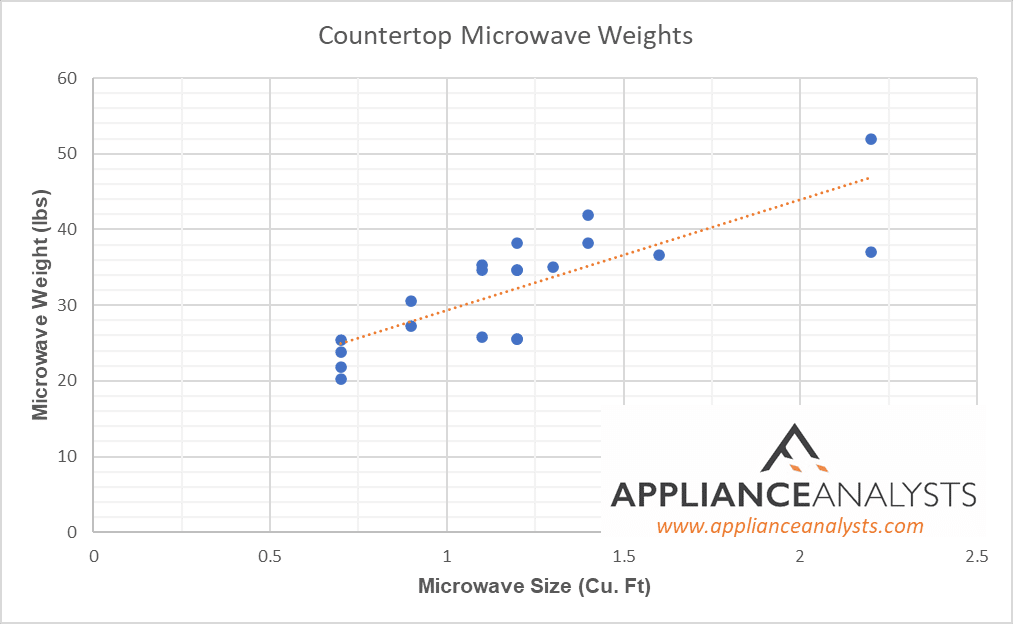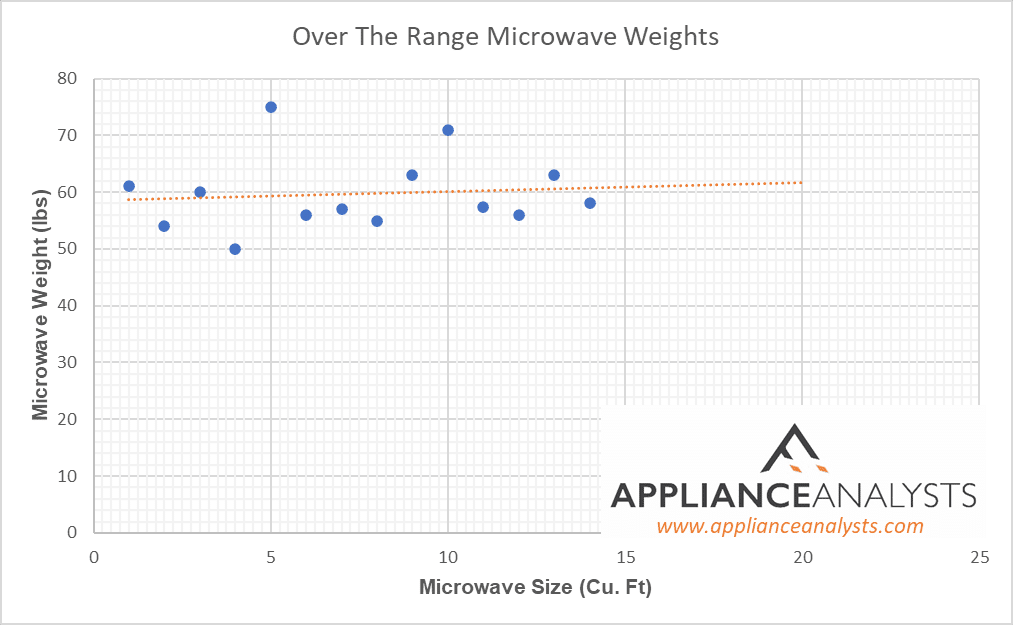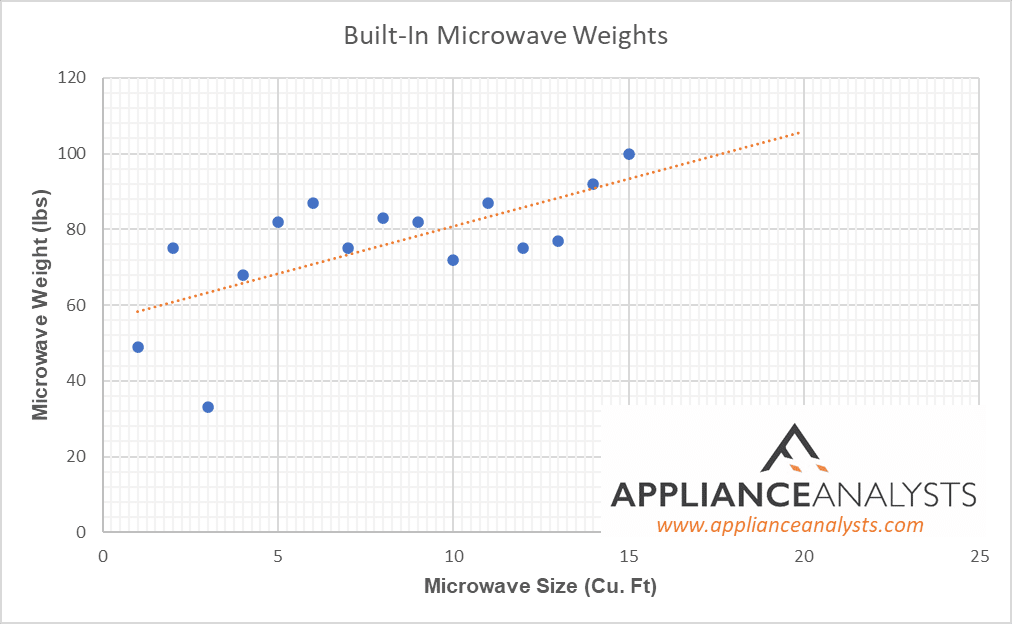Ever wondered how much a microwave weighs?
Welcome to the club! I’ve also often wondered about microwave weight myself and have dived into some research to find out.
For this microwave weight comparison, I collated data from 54 different microwave models, including countertop microwaves (20), over-the-range microwaves (14), built-in microwaves (15), and drawer microwaves (5).
So how much does a microwave weigh?
A microwave weighs approximately 55 lbs on average. Though a microwave’s weight varies depending on size and type – from a minimum of 20lb (small countertop microwaves) up to 100lb (bulky built-in microwaves).
Want more detail about each microwave type? Then read on for a rollercoaster journey of microwave data!
How Much Does A Countertop Microwave Weigh?
Let’s start with the most common type and build upwards.
Here’s the stats for the 20 Countertop Microwaves – with Internal Size (in cubic feet) charted against weight (lbs).

As you can see, a countertop microwave’s weight varies between 23-45lbs – with the average clocking in around 32lbs. Countertop microwaves are, by far, the most compact and lightest of all microwave types and reflect their portability (and often cheaper pricing).
Countertop microwaves are also extremely linear in terms of their weight vs. their internal size, unlike other types, which surprisingly don’t follow this rule. In fact, the trendline of countertop microwave weight vs their size is an (extremely satisfying) linear one.
Raw Data:
| Brand | Size (cu.ft) | Watts | Weight (lbs) | Link |
|---|---|---|---|---|
| Toshiba | 1.2 | 1100 | 34.6 | Link |
| Toshiba | 0.9 | 900 | 27.3 | Link |
| Panasonic | 1.2 | 1480 | 25.5 | Link |
| Toshiba | 1.6 | 1200 | 36.6 | Link |
| Toshiba | 1.2 | 1100 | 34.6 | Link |
| Black & Decker | 0.9 | 900 | 30.6 | Link |
| Black & Decker | 0.7 | 700 | 23.8 | Link |
| Black & Decker | 1.1 | 1000 | 34.6 | Link |
| Black & Decker | 1.4 | 1000 | 38.2 | Link |
| AmazonBasics | 0.7 | 700 | 21.9 | Link |
| Toshiba | 1.3 | 1100 | 35.05 | Link |
| Panasonic | 1.2 | 1200 | 25.5 | Link |
| Farberware | 1.1 | 1000 | 25.8 | Link |
| Panasonic | 2.2 | 1250 | 37 | Link |
| Galanz | 0.7 | 700 | 25.4 | Link |
| COMFEE | 0.7 | 700 | 20.3 | Link |
| Sharp | 2.2 | 1200 | 52 | Link |
| Samsung | 1.1 | 1000 | 35.3 | Link |
| Samsung | 1.4 | 950 | 41.9 | Link |
| Farberware | 1.2 | 1100 | 38.2 | Link |
How Much Does an Over The Range Microwave Weigh?
Moving on to the second most common type, over-the-range microwaves can get away with carrying much more weight since they’re not portable.
However, they’re second-lightest, considering the bearing capacity of most ranges.

From the dataset above, over-the-range microwaves weigh between 54lbs to 71lbs – with the average clocking in at an even 60lbs.
The curious point here is the lack of change in the graph. It seems that the weight of a microwave is almost always close to 60 lbs, no matter the size. Especially compared to countertop microwaves.
The weight similarity may be due to limitations expressed by the ranges themselves – or, alternatively, manufacturers aren’t detailed in their weight quotations. (For validation, I’ve included links to all these models and weights in the raw data).
Regardless, if you’re planning to install an over-the-range microwave, you can sleep safe knowing that it will be approximately 60 lbs!
Tip: If you want to know how much running your microwave costs, please use our free calculator.
Raw Data:
| Brand | Size (cu.ft) | Watts | Weight (lbs) | Link |
|---|---|---|---|---|
| Sharp | 1.8 | 1100 | 61 | Link |
| Sharp | 1.5 | 1000 | 54 | Link |
| Frigidaire | 1.7 | 1000 | 60 | Link |
| Samsung | 2.1 | 1000 | 50 | Link |
| GE | 1.7 | 1000 | 75 | Link |
| Samsung | 1.8 | 1000 | 56 | Link |
| Frigidaire | 1.8 | 1000 | 57.1 | Link |
| Avanti | 1.3 | 1000 | 55 | Link |
| GE | 1.6 | 1000 | 63 | Link |
| Sharp | 1.1 | 850 | 71 | Link |
| Cosmo | 1.3 | 1000 | 57.3 | Link |
| GE | 1.6 | 1000 | 56 | Link |
| GE | 1.6 | 1000 | 63 | Link |
| GE | 2.1 | 1050 | 58 | Link |
How Much Does A Built-In Microwave Weigh?
In my experience, built-in microwaves are tricky to measure. Mostly because they often come as a dynamic duo (with an oven) or they come with a lot of structural components to install it with.
That said, manufacturers do report the overall microwave weight – which is what is illustrated in the graph below:

The data shows built-in microwaves have the largest range – weighing between 33lbs up to 84lbs, averaging 76lbs. We’re getting heavier here, thanks to the increased structural capacity of cabinets (versus ranges).
Curiously, there’s an extreme outlier here. The 2.2 cubic-foot-sized built-in microwaves by Frigidaire (link in the table below) weigh just 49 lbs! I’d like to ask them which scales they used for that.
Regardless, built-in microwaves are clearly quite heavy and are approaching the limit of how much one person should be looking to lift and install.
Raw Data:
| Brand | Size (cu.ft) | Watts | Weight (lbs) | Link |
|---|---|---|---|---|
| Frigidaire | 2.2 | 1200 | 49 | Link |
| GE | 1.7 | 1920 | 75 | Link |
| Summit | 0.9 | 900 | 33 | Link |
| KitchenAid | 1.4 | 1000 | 68 | Link |
| ZLine | 1.6 | 1000 | 82 | Link |
| Frigidaire | 1.6 | 950 | 87 | Link |
| Café | 1.7 | 950 | 75 | Link |
| Bosch | 1.6 | 1200 | 83 | Link |
| Café | 1.7 | 1200 | 82 | Link |
| Bosch | 1.6 | 950 | 72 | Link |
| Frigidaire | 1.6 | 1100 | 87 | Link |
| Bosch | 1.6 | 950 | 75 | Link |
| GE | 1.7 | 950 | 77 | Link |
| Bosch | 1.6 | 1200 | 92 | Link |
| KitchenAid | 1.4 | 950 | 100 | Link |
How Much Do Drawer Microwaves Weigh?
Ah, at last. On to my favorite type of microwave.
If you don’t know what drawer microwaves are, I recommend you check out our review of them. In short, they are the most advanced, ludicrously expensive microwave – but a type worth the money.
Drawer microwaves are installed below your countertop, and the whole “drawer” of the microwave extends out.
With drawer microwaves, you can bend down and place your plate within the large drawer – no awkwardness of squeezing it in, and it’s super easy to lift heavy plates.
In my opinion, they’re perfect for elders, shorter people, or anyone who loves convenience.
| Brand | Size (cu.ft) | Watts | Weight (lbs) | Link |
|---|---|---|---|---|
| Sharp | 1.2 | 950 | 83 | Link |
| Sharp | 1.2 | 950 | 74 | Link |
| Sharp | 1.2 | 950 | 86 | Link |
| Bosch | 1.2 | 950 | 81 | Link |
| Zline | 1.2 | 1000 | 70.5 | Link |
There’s so few drawer microwaves available that it didn’t make sense to present a graph. In addition, they’re all made by the same manufacturer (SHARP) and have the same drawer size (1.2 cubic feet).
So, how heavy is a drawer microwave?
Drawer microwaves weigh between 71lbs and 86lbs – with an average of 79lbs.
The heaviest of the bunch for a good reason – if you’re paying $1,000+ for a microwave, you’ll want all the tech, power, and functionality, which doesn’t come in light packages.
Frequently Asked Questions
Come on.
Are there seriously FAQs about the weight of microwaves?
Well, as it turns out, yes? There are people searching everything on the internet these days – and just in case you’re one of those outliers, I’ve covered some of the related questions below.
How Much Did the First Microwave Weigh?
The first microwave weighed approximately 750 lbs. It was as large as a refrigerator and so inefficient it needed to be water-cooled.
It took around 10 years before they managed to reduce it in size enough to be sold as a domestic appliance.
When Was the Microwave Invented?
Microwaves were invented in 1945 (that’s right, not a single person in the Second World War had even heard of a microwave!).
The creator was a radar engineer – Percy Spencer – who discovered that the radar equipment could melt food.
How Can I Dispose of My Old Microwave Safely?
Like many other appliances, microwaves can’t simply be thrown away in the garbage. Since they have electronics and all sorts of complex components, it’s much better for you and the environment to dispose of your microwave correctly.
There are many options at your disposal, including recycling. Please check out our article on disposing of your old microwave to get all the necessary information.
Conclusion
And that’s all, folks!
I hope this incredibly specific guide has helped answer your questions on microwave weight.
If you have any other questions, please shoot me an e-mail
Now I’m away to question my sanity and have a beer. Did I really write a post on microwave weights? Did you really just read it?
What a world we’re living in.
Thank you very much for sticking with me all the way to the end. If you find this article useful, please check out our related posts below and consider subscribing to our newsletter.
Have a great day!
-Craig.







